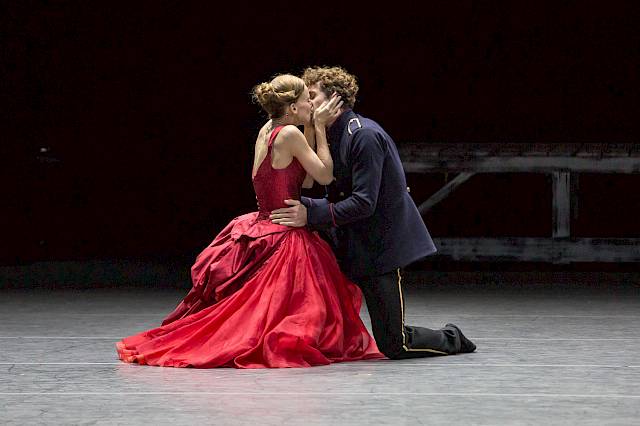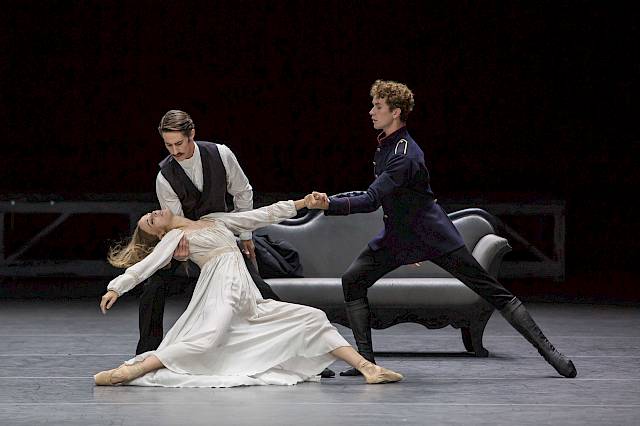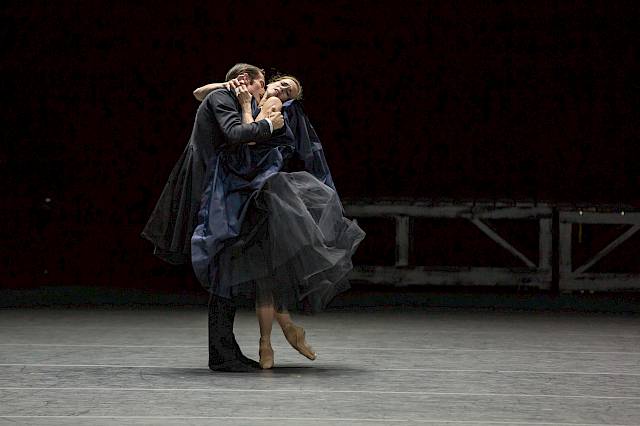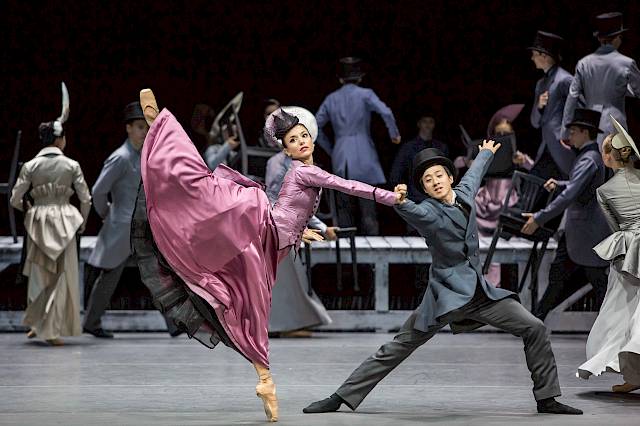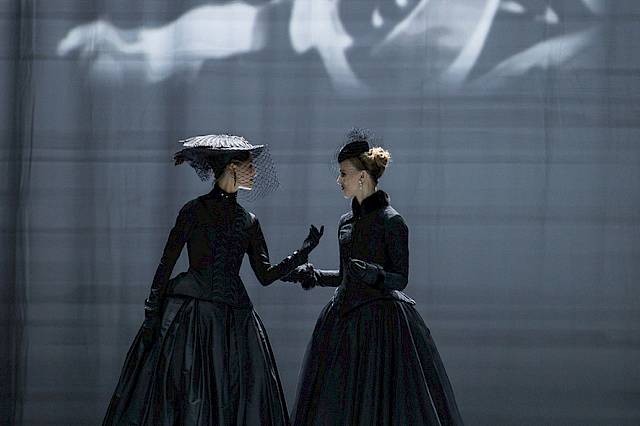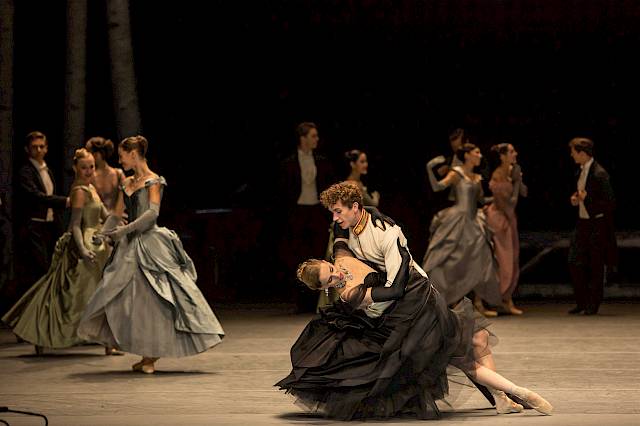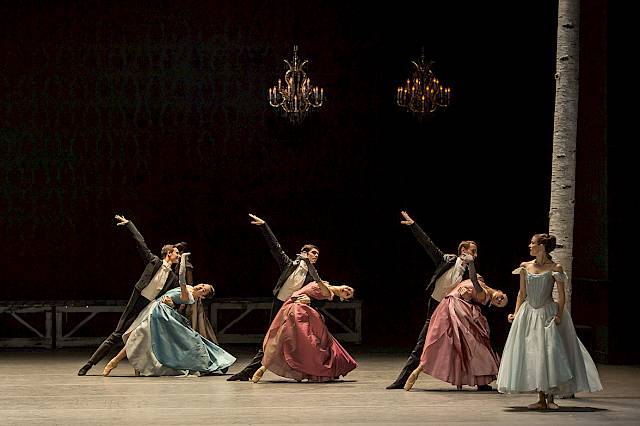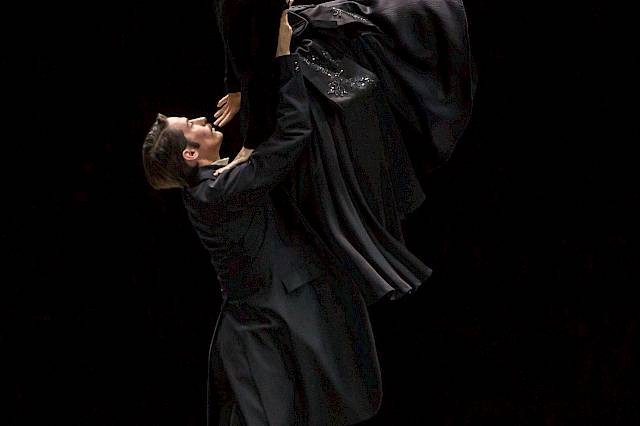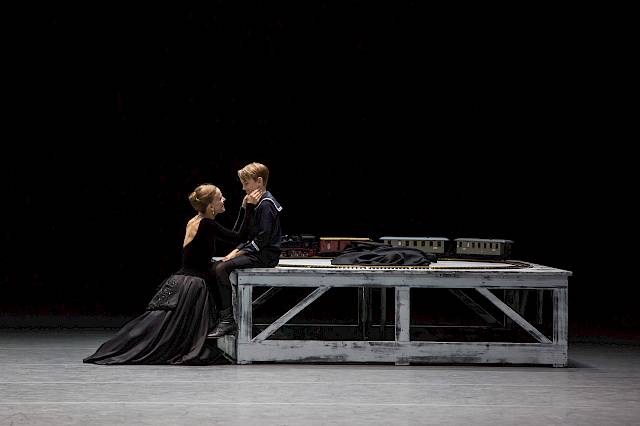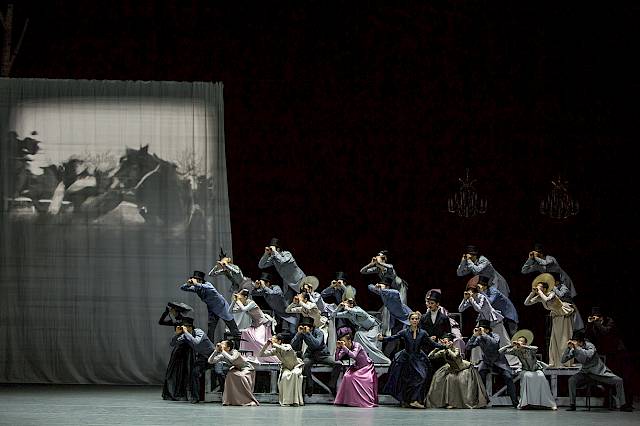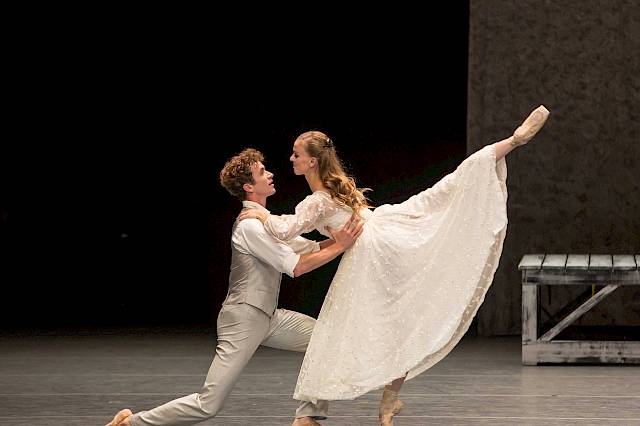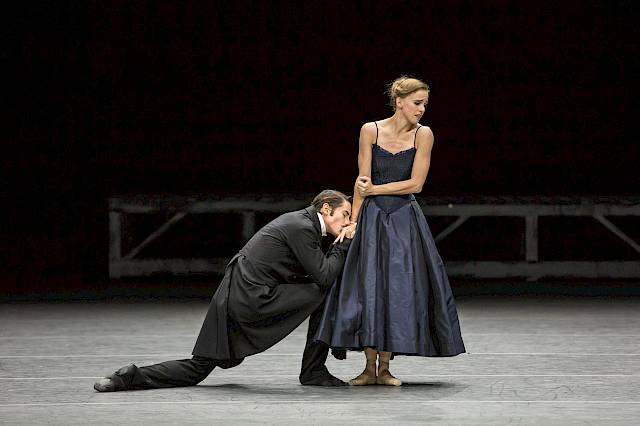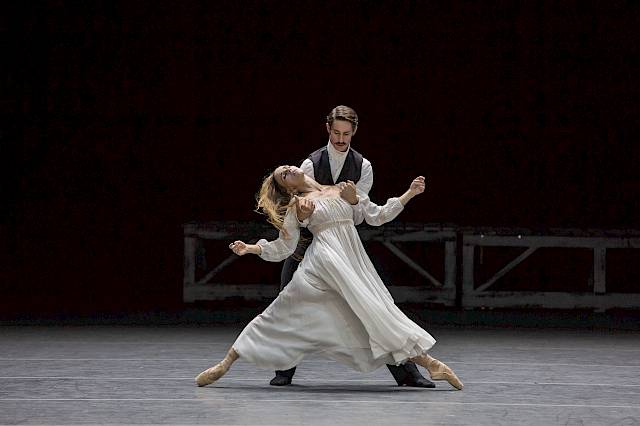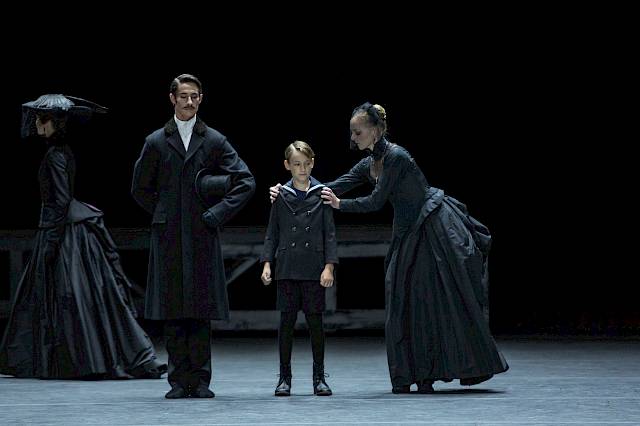Anna Karenina
Ballet by Christian Spuck
After the eponymous novel by Leo Tolstoy (1828-1910)
Music by Sergei Rachmaninoff, Witold Lutosławski, Sulkhan Tsintsadze and Josef Bardanashvili
Duration 2 H. 10 Min. incl. intermission after 1st part after approx. 1 H. Introduction 45 min before the performance.
A co-production with Den Norske Opera & Ballett / Nasjonalballetten, Oslo.
Past performances
March 2023
April 2023
Good to know
Anna Karenina
Abstract
Anna Karenina
The beautiful Anna Karenina is married to a strict, if highly respected, government official in St. Petersburg. But for her, the union is a joyless one. When she meets the easy-going officer Count Wronski, it’s love at first sight – but she is initially reluctant to give in to him. Wronski courts her until she becomes his secret lover. But their affair is soon discovered, and Anna Karenina is ostracized as an adulteress. Anna despairs, caught between love and the moral code of matrimony. Nothing can stop the impending catastrophe.
With Anna Karenina, Leo Tolstoy wrote a novel that achieved international reach. Not only does it tell the story of a love affair that falls prey to prevailing moral concepts, but it also sketches a multi-layered panorama of Russian society at the end of the 19th century. In Tolstoy’s opulent morality tale, Lewin, the honorable landowner, and his wife Kitty, the daughter of St. Petersburg nobility, stand in stark contrast to Anna and Wronski. Their relationship is dominated not by passion, but by responsibility, sincerity, and tenderness, and they find fulfillment in living a happy life in the countryside.
Christian Spuck’s ballet adaption of this demanding novel has found itself a fixed place in the repertoire of great ballet companies the world over. Oslo, Moscow, Munich, and Seoul present the ballet regularly, and the Ballett Zürich was praised for its guest performances of the production in Tel Aviv and Hong Kong. The titular heroine’s fate lies at the center of the story Spuck tells, but the Ballett Zürich’s ballet director also turns his attention to the other main characters’ lives. Set to symphonic music by Sergei Rachmaninoff and Witold Lutosławski, he translates the fate of Tolstoy’s heroes into haunting choreographic images.
Anna Karenina
Synopsis
Anna Karenina
Prologue
Martin Donner: Trains I
Sergei Rachmaninoff: Moment musical op. 16 no. 3 B minor
Salon I
Stiva Oblonski is cheating on his wife Dolly with the female maids. Kitty Shcherbatskaya is being pursued by landowner Konstantin Levin, who has come to town specifically for this purpose.
Sergei Rachmaninoff: Symphonic Dances op. 45,
2. Andante con moto (Tempo di Valse)
Arrival in Moscow
Anna Karenina has come to Moscow from St. Petersburg where she intends to mediate between Stiva and Dolly. Stiva is waiting for Anna on the platform, while her travelling acquaintance, Countess Vronskaya, is being collected by her son Alexei. Anna Karenina and Alexei Vronsky are introduced to one another, and this first sighting remains unforgettable for both.
Witold Lutosławski: Novelette for Orchestra, No. 1 Announcement
The ball
Levin asks for Kitty’s hand in marriage and she turns him down. She is infatuated with Vronsky, and is hoping he will propose to her. However, Vronsky’s only desire is to see Anna Karenina again at the ball. When Anna appears and Vronsky only has eyes for her, Kitty’s world falls apart. Anna realises that she is the reason for Kitty’s destroyed hopes and leaves.
Sergei Rachmaninoff:
Symphonic Dances op. 45, 2. Andante con moto (Tempo di Valse)
To St. Petersburg
Vronsky follows Anna to St. Petersburg. They become closer during the journey. In St. Petersburg, Anna Karenina is collected by her husband Alexei and their son Seryozha.
Sergei Rachmaninoff: Rhapsody on a Theme of Paganini op. 43 for piano and orchestra, Variation 12 Martin Donner: Trains II
In the country I
After his refused proposal, Levin flees to the solitude of his estate and avoids society.
Sergei Rachmaninoff (Arr.: Christophe Barwinek):
Noch' pechal'na, op. 26 No. 12 (The Night is Sad)
Betsy’s salon
The salon of Betsy Tverskaya, a friend of Anna’s, is the meeting point of the decadent Petersburg society. While Dolly and Stiva continue to argue here, Anna and Vronsky enjoy their reunion. When Karenin turns up to collect his wife, she refuses to go home with him. The Karenins are the subject of much discussion in the salon: A shadow has been cast over Anna’s reputation – Vronsky.
As society becomes more distant, Anna and Vronsky’s passion for one another can no longer be assuaged. Vronsky’s love allows Anna to forget the feelings of guilt and shame about the breakdown of her marriage.
Sergei Rachmaninoff: Piano Concert no. 2 c-minor op. 18, 3rd movement
Witold Lutosławski: Chain 3 for Orchestra, III. 38
Horse racing
The distinguished society meets at a horse race, including the Karenins, the Oblonskis, Betsy and Countess Vronskaya. The fact that Anna screams when Vronsky falls with his horse is proof of her unfaithfulness for Karenin and those present. Karenin demands the fulfilment of marital obligations from Anna.
Sergei Rachmaninoff: Rhapsody on a Theme of Paganini op. 43,
Variations no. 8 and no. 9
Witold Lutosławski: Piano concert, 2nd movement
In the country II
Levin takes part in haymaking, forgets his heartache and finds new meaning in life in the shared work with his farmers.
The transformed Kitty comes to the country, and she and Levin become closer to one another.
Martin Donner: Sensen
Sergei Rachmaninoff (Arr.: Christophe Barwinek):
Ne poy, krasavitsa! op. 4 no. 4 (Don’t sing, beautiful)
At the home of the Karenins
After the birth of Vronsky’s daughter, Anna is under threat of death. This situation causes Karenin to forgive her and his love rival. Vronsky, who fears that Anna will return to her husband, attempts suicide.
Sergei Rachmaninoff (Arr.: Christophe Barwinek):
Rhapsody on a Theme of Paganini op. 43, Variation 17
Witold Lutosławski: Piano Concert, 1st Movement
Break
Prelude:
Witold Lutosławski: Novelette for Orchestras, no. 1 Announcement
Italy/Russia
Vronsky is in Italy with Anna. She has left her old life behind - including Seryozha. Vronsky has given up his career in the military for her. They enjoy their abundance of happiness as a pair, but soon Anna misses her son, while Vronsky misses life in society. They return to Russia. Dolly appears to have come to terms with remaining at the side of the notoriously unfaithful Stiva.
Sergei Rachmaninoff: Piano Concert no. 2 c minor op. 18, 2nd Movement
Wedding
Kitty and Levin have come together and marry.
Sulkhan Tsintsadze (Arr.: Christophe Barwinek):
Miniatures for String Quartet, 5th harmony
Seryozha’s birthday
In secret, Anna visits her son Seryozha, who is now being looked after by the confidante of the Karenins, Lidia Ivanovna. They both bring the reunion of mother and son to an abrupt end. Anna and Karenin have a heated discussion, after which Anna remains alone and shattered.
Sergei Rachmaninoff: Prelude C-sharp minor op. 3 no. 2
Loneliness I
Anna is devastated. She now doubts Vronsky’s faithfulness and tries to numb her pain and jealousy with opium.
Sergei Rachmaninoff (Arr.: Christophe Barwinek):
Uvyal tsvetok o. op. (The flower is withered; Text page 74)
Isolation
While Vronsky is able to continue to take part in public life, Anna is perceived as an adulteress and is shunned by and cut off from society. Even her once friend Betsy turns away from her. Her jealousy and delusions turn obsessive, and she suspects that Princess Sorokina, who Countess Vronskaya has chosen for her son, is a love rival.
Witold Lutosławski: Novelette for Orchestra, No. 2 First Event
Witold Lutosławski: Novelette for Orchestra, No. 1 Announcement
Sergei Rachmaninoff: Prelude F-sharp minor op. 23 No.1
Loneliness ll/Anna’s death
All relationships and ties have dissolved for Anna, and Vronsky is also no longer a reason for her to stop. She kills herself.
Josef Bardanashvili: Concerto quasi una fantasia, 2. Sostenuto
Sergei Rachmaninoff: Ne poy, krasavitsa! op. 4 No. 4 (Prelude)
Biographies
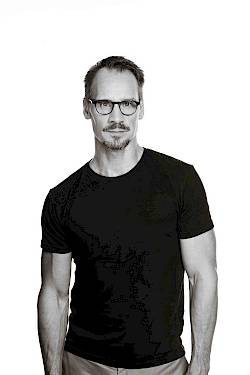
Christian Spuck,
Christian Spuck
Christian Spuck stammt aus Marburg und wurde an der John Cranko Schule in Stuttgart ausgebildet. Seine tänzerische Laufbahn begann er in Jan Lauwers’ Needcompany und Anne Teresa de Keersmaekers Ensemble «Rosas». 1995 wurde er Mitglied des Stuttgarter Balletts und war von 2001 bis 2012 Hauschoreograf der Compagnie. In Stuttgart kreierte er fünfzehn Uraufführungen, darunter die Handlungsballette Lulu. Eine Monstretragödie nach Frank Wedekind, Der Sandmann und Das Fräulein von S. nach E.T.A. Hoffmann. Darüber hinaus hat Christian Spuck mit zahlreichen namhaften Ballettcompagnien in Europa und den USA gearbeitet. Für das Königliche Ballett Flandern entstand 2006 The Return of Ulysses, beim Norwegischen Nationalballett Oslo wurde Woyzeck nach Georg Büchner uraufgeführt. Das Ballett Die Kinder beim Aalto Ballett Essen wurde für den «Prix Benois de la Danse» nominiert, das ebenfalls in Essen uraufgeführte Ballett Leonce und Lena nach Georg Büchner wurde von den Grands Ballets Canadiens de Montréal, dem Charlotte Ballet, USA, dem Tschechischen Nationalballett Prag und vom Stuttgarter Ballett übernommen. Die Uraufführung von Poppea//Poppea für Gauthier Dance am Theaterhaus Stuttgart wurde 2010 von der Zeitschrift «Dance Europe» zu den zehn erfolgreichsten Tanzproduktionen weltweit gewählt sowie mit dem deutschen Theaterpreis Der Faust 2011 und dem italienischen «Danza/Danza-Award» ausgezeichnet. Christian Spuck hat auch Opern inszeniert: Auf Glucks Orphée et Euridice an der Staatsoper Stuttgart folgten Verdis Falstaff am Staatstheater Wiesbaden sowie Berlioz’ La Damnation de Faust und Wagners Fliegender Holländer an der Deutschen Oper Berlin. Von 2012 bis 2023 war Christian Spuck Direktor des Balletts Zürich. Hier waren seine Choreografien Romeo und Julia, Leonce und Lena, Woyzeck, Der Sandmann, Messa da Requiem, Nussknacker und Mausekönig, Dornröschen und Monteverdi zu sehen. Das 2014 in Zürich uraufgeführte Ballett Anna Karenina nach Lew Tolstoi wurde in Oslo, am Moskauer Stanislawski-Theater, vom Koreanischen Nationalballett und vom Bayerischen Staatsballett ins Repertoire übernommen. 2018 hatte in Zürich Spucks Ballett Winterreise Premiere, für das er mit dem «Prix Benois de la Danse 2019» ausgezeichnet wurde. 2019 folgte beim Ballett Zürich Helmut Lachenmanns Das Mädchen mit den Schwefelhölzern (Auszeichnung als «Produktion des Jahres und Kompanie des Jahres für das Ballett Zürich durch die Zeitschrift tanz). Für das Moskauer Bolschoitheater kreierte er 2021 sein Ballett Orlando nach Virginia Woolf. Spucks Messa da Requiem wurde nicht nur zum Adelaide Festival nach Australien eingeladen, sondern auch vom Het Nationale Oper & Ballet Amsterdam und vom Finnischen Nationalballett übernommen. Seit Beginn der Saison 2023/24 ist Christian Spuck Intendant des Staatsballetts Berlin.
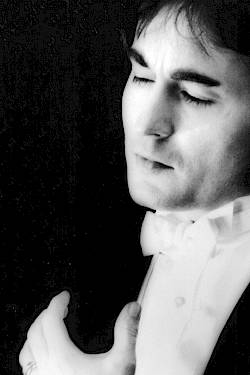
Paul Connelly,
Paul Connelly
Paul Connelly debütierte 23-jährig als Dirigent mit Gershwins Porgy and Bess im Rahmen einer Tournee der Houston Grand Opera. 1980 wurde er auf Einladung von Michail Baryshnikov Erster Kapellmeister des American Ballet Theatre und arbeitete dort mit Choreografen wie Jerome Robbins, George Balanchine und Anthony Tudor. Während dieser Zeit dirigierte er auch Vorstellungen des New York City Ballet sowie Gala-Veranstaltungen wie Nureyev and Friends und Baryshnikov and Co., ausserdem war er Gastdirigent beim National Ballet of Canada. Während der Zeit beim ABT war er an zahlreichen Film- und Fernsehprojekten beteiligt (u.a. Don Quixote). Zu seinen Opernaktivitäten in dieser Zeit gehören Brittens Death in Venice, Debussys Pelléas et Mélisande sowie Purcells Dido and Aeneas. Nach der musikalischen Leitung einer Ballettgala an der Wiener Staatsoper wurde ihm dort Rossinis Barbiere di Siviglia anvertraut, ein Erfolg, der den Anfang einer intensiven Dirigententätigkeit in Europa markiert. Einladungen führten ihn zum Staatsballett Berlin, das Ballett der Opéra Paris (Verfilmungen von Neumeiers Sylvia, Balanchines Jewels, Giselle, Roland-Petit-Abend), zum Orchestre Colonne in Paris, an das Opernhaus Nizza, ans Teatro di San Carlo in Neapel, an die Oper Oslo, zum Royal Ballet in London und in Birmingham, zum Het Nationale Ballet in Amsterdam, zum Tokyo Ballet, zum Semperoper Ballett Dresden und an die Mailänder Scala, wo er auf Einladung von Riccardo Muti die Opern Il turco in Italia, Die Zauberflöte und Don Giovanni dirigierte. An der Scala leitete er auch eine Reihe von Ballettaufführungen, unter anderem Giselle, die auch verfilmt wurde. Auf DVD erschienen Mauro Bigonzettis Caravaggio mit dem Staatsballett Berlin und Nureyews Nussknacker mit dem Ballett der Wiener Staatsoper. Unlängst dirigierte er Kenneth MacMillans Mayerling an der Staatsoper Budapest. Geplant sind The Cellist von Cathy Marston beim Ballett Zürich sowie eine Neuproduktion von Coppélia in der Choreografie von Alexei Ratmansky an der Mailänder Scala.

Michael Richter,
Michael Richter
Michael Richter wurde in Wien geboren und studierte Orchesterdirigieren bei Leopold Hager sowie Korrepetition bei Konrad Leitner an der dortigen Universität für Musik und Darstellende Kunst. Von 2000 bis 2003 war er als Solokorrepetitor mit Dirigierverpflichtung am Badischen Staatstheater Karlsruhe engagiert und dirigierte dort u.a. Aufführungen von Le nozze di Figaro, Die Fledermaus und Prokofjews Romeo und Julia. Seit 2003 ist Michael Richter am Opernhaus Zürich engagiert, zunächst als Solokorrepetitor und seit 2012 als Studienleiter. Er arbeitete mit namhaften Dirigenten wie Franz Welser-Möst, Ingo Metzmacher, Fabio Luisi und Heinz Holliger sowie mit Sängern wie Neil Shicoff, Jonas Kaufmann und Peter Seiffert, gab Konzerte als Pianist und Dirigent in verschiedenen Ländern Europas und arbeitete für die Salzburger Festspiele wie auch für das Lucerne Festival. 2017/18 dirigierte er die Uraufführung von Xavier Dayers Der Traum von Dir auf der Studiobühne des Opernhauses Zürich; 2018/19 sowie in der folgenden Spielzeit leitete er Vorstellungen von Humperdincks Hänsel und Gretel. 2022/23 übernahm er die musikalische Leitung von Alice im Wunderland am Opernhaus Zürich.
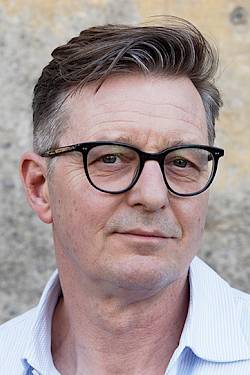
Jörg Zielinski,
Jörg Zielinski
Jörg Zielinski stammt aus Berlin und lebt seit 1991 in der Schweiz. Seine Ausbildung und sein Studium absolvierte er in Berlin, Basel, Zürich und Rochester (NY). Als Produktionsleiter am Theater Basel und leitender Mitarbeiter bei «The Really Useful Group» sammelte er Erfahrungen mit internationalen Theaterproduktionen. Er arbeitete an der Expo.02 in Yverdon-les-Bains sowie bei der Rauminszenierung Hotel Offen in Baden mit. Seine Designerfahrungen sammelte er bei Vitra. Als Leiter des Ausstattungswesens am Opernhaus Zürich arbeitete er mit dem Shanghai Opera House zusammen. Aus dieser Zusammenarbeit entstanden Kontakte mit der National Academy of Chinese Theatre Arts in Peking und der Zürcher Hochschule der Künste, wo er zu Vorträgen eingeladen wurde. Er entwirft und realisiert Bühnenbilder und szenische Einrichtungen. Neben diversen freien Projekten entstanden Entwürfe für das Opernhaus Zürich, das Bayerische Staatsballett, das Stanislavski-Danchenko-Theater Moskau, das Koreanische Staatsballett Seoul, das Norwegische Staatsballett Oslo und das Londoner Studio «United Visual Artists».
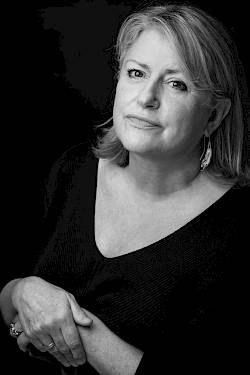
Emma Ryott,
Emma Ryott
Emma Ryott trained at Trent Polytechnic with a BA in Theatre Design. Ever since their first collaboration in 2003, Emma Ryott and Christian Spuck continued working together for ballet and opera productions, such as Lulu. Eine Monstretragödie in Stuttgart, Anna Karenina in Zurich, Oslo and Moscow, Romeo und Julia in Zurich, Woyzeck in Oslo and Zurich, Das Fräulein von S. in Stuttgart, Leonce und Lena in Montréal, Stuttgart und Zurich, Der Sandmann in Stuttgart und Zurich, Poppea / Poppea und Don Q. for Gauthier Dance, The Return of Ulysses for das Royal Ballet of Flanders, La Damnation de Faust at the Deutsche Oper Berlin, Falstaff in Wiesbaden and Orfeo ed Euridice in Stuttgart. She also works closely with director Keith Warner. Their collaborations include Mathis der Maler at Theater an der Wien, Manon Lescaut at the English National Opera as well as La Damnation de Faust and Harbison’s The Great Gatsby at the Semperoper Dresden. Other designs were created for Sunset Boulevard and Manon Lescaut (Goteborg), Otello (Salzburg), The Heart of Robin Hood for the Royal Shakespeare Company (awarded with Elliot Norton Award for outstanding design), Rock ‘n Roll by Tom Stoppard (London Royal Court, West End and Broadway), Chekhov-trilogy directed by Jonathan Kent (National Theatre, London) and the New Year’s Day Concert, Vienna, 2016.

Martin Gebhardt,
Martin Gebhardt
Martin Gebhardt war Lichtgestalter und Beleuchtungsmeister bei John Neumeiers Hamburg Ballett. Ab 2002 arbeitete er mit Heinz Spoerli und dem Ballett Zürich zusammen. Ballettproduktionen der beiden Compagnien führten ihn an renommierte Theater in Europa, Asien und Amerika. Am Opernhaus Zürich schuf er das Lichtdesign für Inszenierungen von Jürgen Flimm, David Alden, Jan Philipp Gloger, Grischa Asagaroff, Matthias Hartmann, David Pountney, Moshe Leiser/Patrice Caurier, Damiano Michieletto und Achim Freyer. Bei den Salzburger Festspielen kreierte er die Lichtgestaltung für La bohème und eine Neufassung von Spoerlis Der Tod und das Mädchen. Seit der Spielzeit 2012/13 ist Martin Gebhardt Leiter des Beleuchtungswesens am Opernhaus Zürich. Eine enge Zusammenarbeit verbindet ihn heute mit dem Choreografen Christian Spuck (u.a. Winterreise, Nussknacker und Mausekönig, Messa da Requiem, Anna Karenina, Woyzeck, Der Sandmann, Leonce und Lena, Das Mädchen mit den Schwefelhölzern). Er war ausserdem Lichtdesigner für die Choreografen Edward Clug (u.a. Strings, Le Sacre du printemps und Faust in Zürich), Alexei Ratmansky, Wayne McGregor, Marco Goecke, und Douglas Lee. Mit Christoph Marthaler und Anna Viebrock arbeitete er beim Händel-Abend Sale und Rossinis Il viaggio a Reims in Zürich sowie bei Lulu an der Hamburgischen Staatsoper zusammen und mit Jossi Wieler und Sergio Morabito an der Oper Genf für Les Huguenots. 2023 gestaltete er das Licht für Spucks Ballett Bovary beim Staatsballett Berlin und 2024 Rossinis Tancredi an den Bregenzer Festspielen. Ausserdem war er Lichtdesigner bei Atonement von Cathy Marston am Opernhaus Zürich.
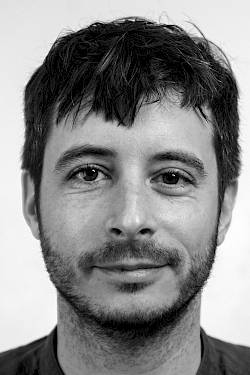
Tieni Burkhalter,
Tieni Burkhalter
Tieni Burkhalter studierte Bildende Kunst an der Zürcher Hochschule der Künste (ZHdK), wo er sich auf Video und Videoinstallation spezialisierte. Nachdem seine Werke vorwiegend in Galerien und an Experimentalfilmfestivals gezeigt wurden, arbeitet er seit 2009 für die Bühne. Als Videoproduzent ist er eng mit dem Opernhaus Zürich verbunden. Seine Bühnenarbeit führte ihn ausserdem zu Theatern in Berlin, Hamburg, Paris, Moskau, Oslo und Savonlinna. Am Opernhaus Zürich arbeitete er mit Andreas Homoki (Der fliegende Holländer, Das Land des Lächelns, Das Rheingold, Siegfried und Die Walküre), Evgeny Titov (Lessons in Love and Violence und L’Orfeo), Jan Philipp Gloger (Die Csárdásfürstin und Le nozze di Figaro), Adele Thomas (Il trovatore), Rainer Holzapfel (Die Odyssee), Nina Russi (Coraline) und Kai Anne Schuhmacher (Jim Knopf und Lukas der Lokomotivführer). Für das Ballett Zürich produzierte er Videos für Christian Spuck (Anna Karenina und Das Mädchen mit den Schwefelhölzern), Marcos Morau (Nachtträume), Edward Clug (Faust) und Douglas Lee (A-Life). Er war ferner am Opernfestival Savonlinna mit Philipp Himmelmann für Aida tätig, in Berlin mit Christian Spuck für Madame Bovary und wirkt seit vielen Jahren in Dmitri Tcherniakovs Inszenierungen mit: Pelléas et Mélisande und Die Sache Makropulos am Opernhaus Zürich, Senza Sangue/Herzog Blaubarts Burg, Elektra und Salome an der Staatsoper Hamburg, La Fille de Neige und Les Troyens an der Opéra National de Paris und Tristan und Isolde an der Staatsoper Unter den Linden in Berlin.
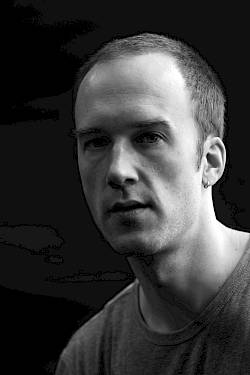
Martin Donner,
Martin Donner
Martin Donner, Jahrgang 1974, ist seit Mitte der neunziger Jahre als Komponist, Produzent und Musiker tätig. Musikalisch vielseitig interessiert, arbeitet er seit 2000 als freischaffender Künstler in verschiedenen Projekten und Formationen. Dabei setzte er sich intensiv mit der Ästhetik und Produktion elektronischer Musik auseinander. In Kooperation mit der Agentur «Publikmacher» baute er ein digitales Klangarchiv für das Internet auf und war von 2001-2003 Dozent für Audioproduktion an der Medienwerkstatt Stuttgart. Seit 2002 komponiert er regelmässig Musik für verschiedene internationale Theater und Tanzkompanien. Dabei arbeitete er mit Christian Spuck, Rene Pollesch und Hans Kresnik zusammen. Von 2004 bis 2010 lebte Donner in Berlin, wo er einem fortbildenden Studium der Kultur- und Medienwissenschaften an der Humboldt Universität nachging. In Folge entstanden neben seiner Musik auch theoretische Texte und Klanginstallationen. Seit 2010 lebt Donner wieder in Stuttgart.
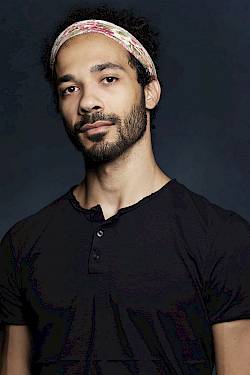
Lucas Valente,
Lucas Valente
Lucas Valente comes from Brazil. He studied performing arts and philosophy at the University of São Paulo. His first engagement was with the Ballet Company Laura Alonso in Havana and he was involved in the «Arsenale della Danza» project at the Venice Biennale in 2012. From 2012 to 2016 he danced in the São Paulo Companhia de Dança, where he appeared in choreographies by Edouard Lock, Marco Goecke, William Forsythe, Nacho Duato, and Jiří Kylián, among others. He danced in choreographies by Richard Siegal at the Ballet of Difference in 2017. He has been a member of Ballett Zürich since the 2017/18 season. He presented his choreography Trees Die Standing as a part of the «Junge Choreografen» series. He has appeared as Tybalt/Count Capulet in Christian Spuck’s Romeo und Julia and appeared in Crystal Pite’s Emergence.
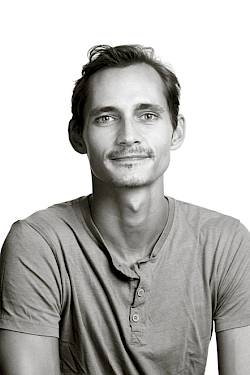
Dominik White Slavkovský,
Dominik White Slavkovský
Dominik White Slavkovský is Slovakian. Trained at the Bratislava Dance Conservatory, he danced for five years in the Ballet of the Slovak National Theater in Bratislava, most recently as a semi-soloist. He has been a member of Ballett Zürich since the 2014/15 season. In choreographies by Christian Spuck he performed the title role of "Woyzeck", as Drosselmeier in "Nutcracker and Mouse King", Coppelius in "The Sandman", Paris in "Romeo and Juliet" and as Death in Edward Clug's "Peer Gynt". He has also danced in choreographies by George Balanchine, Uwe Scholz, Alexei Ratmansky, Jiří Kylián, William Forsythe, Crystal Pite, Hans van Manen, Nacho Duato, Marco Goecke, James Kudelka, Vladimir Malakhov and many others. In the series "Young Choreographers" he showed his pieces "How to save the world", "Conspiracy" and "Boyband"
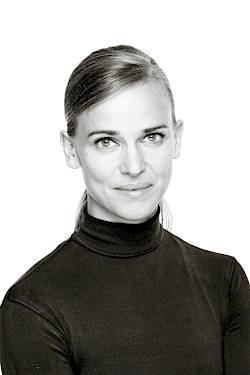
Katja Wünsche,
Katja Wünsche
Katja Wünsche comes from Dresden and was trained at the Staatliche Ballettschule Berlin. She has won prizes at numerous ballet competitions. From 1999 to 2012 she danced in the Stuttgart Ballet, including as a principal dance from 2006. She danced leading roles in choreographies by John Cranko (Romeo und Julia, Der Widerspenstigen Zähmung, Onegin), John Neumeier (Endstation Sehnsucht, Die Kameliendame), Marcia Haydée (Dornröschen, La Sylphide, La fille mal gardée) and Christian Spuck (Lulu, Der Sandmann, Leonce und Lena, Das Fräulein von S.) and ballets by Forsythe, Kylián, León/Lightfoot and Goecke. In 2007 she was awarded the German Dance Prize Future (for promising young artists) and the German Theater Prize Der Faust. Katja Wünsche has been a first soloist with Ballett Zürich since the 2012/13 season. She has been seen in Zurich as Julia in Spuck’s Romeo und Julia, Lena in Leonce und Lena, Marie in Woyzeck, Anna Karenina and Kitty in Anna Karenina and Clara in Der Sandmann. She has also performed in choreographies by Sol León/Paul Lightfoot, Douglas Lee, Martin Schläpfer, Wayne McGregor and Marco Goecke. In 2014 she was awarded the «Tanzpreis der Freunde des Balletts Zürich».

Rafaelle Queiroz,
Rafaelle Queiroz
Rafaelle Queiroz is from Brazil. She received her training in Rio de Janeiro and, with a stipend from the Tanzstiftung Birgit Keil, at the Akademie des Tanzes in Mannheim. She was a finalist at the «Prix de Lausanne» and won the Langham Award at the Youth American Grand Prix 2009. She was a member of the Badisches Staatsballett Karlsruhe from 2009 to 2019, where roles included Odette/Odile in Schwanensee by Christopher Wheeldon, Myrtha in Giselle by Peter Wright, the title role in La Sylphide by Peter Schaufuss, Katharina/Bianca in Cranko’s Der Widerspenstigen Zähmung, Julia in Kenneth MacMillan’s Romeo und Julia, and the title role in Rusalka von Jiří Bubeníček. In addition, she appeared in choreographies by Hans van Manen, Heinz Spoerli, Davide Bombana and Reginaldo Oliveira. She joined Ballett Zürich with the 2019/20 season.

Cohen Aitchison-Dugas,
Cohen Aitchison-Dugas
Cohen Aitchison-Dugas is Canadian. He studied at the École Supérieure de Ballet du Québec and at the National Ballet School in Canada. In the 2015/16 season he danced in The Nutcracker with the Grands Ballets Canadiens. After two seasons with the Junior Ballett, he joined Ballett Zürich in the 2017/18 season. He has performed in Jacopo Godani’s rituals from another when, in Filipe Portugal’s Behind the mirror and danced the role of the Mouse King in Christian Spuck’s Nussknacker und Mausekönig, among others. He was awarded with the «Tanzpreis der Freunde des Balletts Zürich» in 2018.
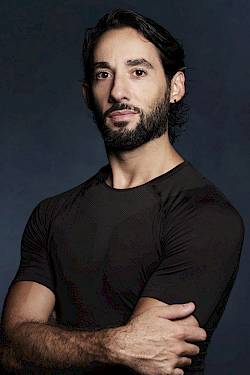
Esteban Berlanga,
Esteban Berlanga
Esteban Berlanga comes from Spain. After his training at the Royal Conservatory of Albacete and the Professional Dance Conservatory of Madrid, he danced at the English National Ballet from 2006 to 2013, where he was appointed principal dancer in 2012. Here he appeared as Prince Siegfried in Schwanensee by Derek Dean, the Prince in Kenneth MacMillan’s Dornröschen, Albrecht in Giselle by Mary Skeaping, the Nutcracker in the choreography by Wayne Eagling and Frédéric in L’Arlésienne by Roland Petit, among others. He also appeared in choreographies by Jiří Kylián and Maurice Béjart. He was nominated for the «Prix Benois de la Danse» for Faun(e) by David Dawson. He was principal dancer in the Compañia Nacional de Danza España from 2013-2018. There he performed as a soloist in choreographies by William Forsythe, Itzik Galili, Roland Petit, Aleix Mañé and Kenneth MacMillan. He has appeared with the English National Ballet, the Australian Ballet, the Nariko Kobayashi Ballet, and the Carmen Cortès Flamenco Company. He has been a member of Ballett Zürich since the 2018/19 season, where he has performed in Christian Spuck’s Winterreise and in the title role of Marco Goecke’s Nijinski.

Jan Casier,
Jan Casier
Jan Casier was born in Belgium. He studied at the Royal Ballet School in Antwerp. From 2008 to 2012 he was a member of the Royal Ballet of Flanders where he danced in ballets by John Cranko, William Forsythe, David Dawson and Christian Spuck. He appeared in David Dawson’s Faun(e) as a guest at the English National Ballet. From 2012 to 2014 he was a member of Ballett Zürich, where he performed roles in numerous Christian Spuck ballets, including Leonce in Leonce und Lena, Paris in Romeo und Julia and the title role of Woyzeck. He also danced in choreographies by Edward Clug, Sol León/Paul Lightfoot, Marco Goecke and Wayne McGregor. From 2014 to 2016 he was a member of the Semperoper Ballett Dresden. There he performed in choreographies by Aaron Watkins (Prince in The Nutcracker), William Forsythe, Alexei Ratmansky, David Dawson and Alexander Ekman. Jan Casier returned to Ballett Zürich in 2016. Since his return, he has danced in Forsythe’s Quintett, Godani’s rituals from another when and the title role in Edward Clug’s Faust and Marco Goecke’s Nijinski. He also appeared as Drosselmeier in Christian Spuck’s Nussknacker und Mausekönig. In 2019, he was named «Dancer of the Year» by the «tanz» magazine and was awarded the «Tanzpreis der Freunde des Balletts Zürich».
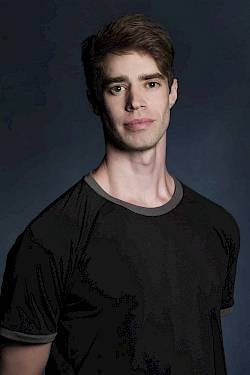
Jesse Fraser,
Jesse Fraser
Jesse Fraser was born in Saskatoon, Canada. He trained at the Royal Winnipeg Ballet School and became a member of the Stuttgart Ballet with the 2010/11 season. There he danced in choreographies by Cranko, MacMillan, Spuck, Haydée, Neumeier, Béjart, Forsythe, Cherkaoui, Goecke, Clug, Volpi, and Stiens. He created the choreographies Back and Forth and Second Self(ie) as a part of the «Young Choreographers» of the Noverre Society series. He has been a member of Ballett Zürich since the 2015/16 season. He has appeared as Paris in Christian Spuck’s Romeo und Julia, as Levin in Spuck’s Anna Karenina, as Hilarion in Patrice Bart’s Giselle, in Marco Goecke’s Petruschka and in choreographies by Jacopo Godani, Jiří Kylián, Hans van Manen, and Crystal Pite. In the 2019/20 season he appeared in Forsythe’s The Second Detail.
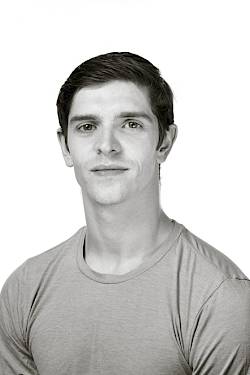
Matthew Knight,
Matthew Knight
Matthew Knight is British. He completed his training at the Elmhurst School and the Royal Ballet School in London. After a season with the Junior Ballett, he joined Ballett Zürich in the 2014/15 season. He presented Jane Doe and Mocambo as part of the «Junge Choreografen» series. He has danced in choreographies by Mats Ek (Cavalier in Dornröschen), William Forsythe, Marco Goecke (Moor in Petruschka), Jiří Kylián, Douglas Lee, Sol León/Paul Lightfoot, Hans van Manen, Wayne McGregor, Ohad Naharin, Crystal Pite, and Filipe Portugal. He was Leonce in Christian Spuck’s Leonce und Lena, Nathanael in Spuck’s Der Sandmann and the Clown in Spuck’s Nussknacker und Mausekönig. In 2018 he also appeared as the title roles in Edward Clug’s Faust and in Marco Goecke’s Nijinski. In 2016 he was awarded the «Tanzpreis der Freunde des Balletts Zürich».
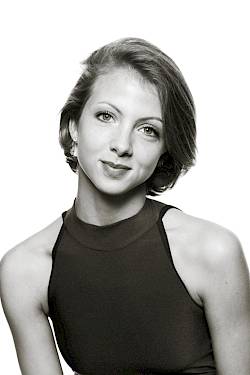
Michelle Willems,
Michelle Willems
Michelle Willems is French. She studied at the Bolshoi Ballet Academy and at the Atelier Rudra-Béjart in Lausanne. After two seasons with the Junior Ballett, she joined Ballett Zürich in the 2016/17 season. After solo roles in Giselle and Schwanensee, she danced Kitty in Christian Spuck’s Anna Karenina, Marie in Spuck’s Nussknacker und Mausekönig and Gretchen in Edward Clug’s Faust, and in Spuck’s Das Mädchen mit den Schwefelhölzern. She has also appeared in choreographies by William Forsythe, Jiří Kylián, Marco Goecke, Crystal Pite, George Balanchine, Ohad Naharin, Douglas Lee, and Filipe Portugal She was awarded the «Tanzpreis der Freunde des Balletts Zürich» in 2018.
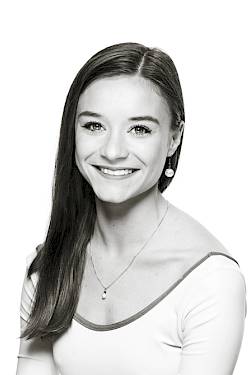
Emma Antrobus,
Emma Antrobus
Emma Antrobus comes from Australia. She studied at the Lamont Dance Theatre, at the Conlan College in Sydney and at the Ballett Akademie of the Hochschule für Musik und Theater in Munich. After two seasons with the Junior Ballett, she joined Ballett Zürich with the 2019/20 season. She danced in choreographies by Christian Spuck (including Das Mädchen mit den Schwefelhölzern), Edward Clug, Crystal Pite, and Ohad Naharin. In 2018, she was awarded the «Tanzpreis der Freunde des Balletts Zürich».

Daniel Mulligan,
Daniel Mulligan
Daniel Mulligan comes from Great Britain and studied at the Royal Ballet School in London. After two seasons with the Junior Ballett, he joined Ballett Zürich in the 2009/10 season. He has appeared as a soloist in many of Heinz Spoerli’s choreographies. He danced Mercutio/Benvolio in Christian Spuck’s Romeo und Julia as well as in ballets by Mats Ek (Dornröschen), Hans van Manen (Solo, Kammerballett), Edward Clug (Chamber Minds, Le Sacre du printemps), Sol León/Paul Lightfoot (Skew-Whiff, Speak for Yourself), William Forsythe (Quintett), Jiří Kylián (Gods and Dogs, Stepping Stones, Sweet Dreams), Ohad Naharin (Minus 16), Marco Goecke (Petruschka), Filipe Portugal (Corpus), Douglas Lee, and Crystal Pite. Recent leading roles have included Mephisto in Faust by Edward Clug, Fritz and the Clown in Spuck’s Nussknacker und Mausekönig, as well as Stiva in Spuck’s Anna Karenina.
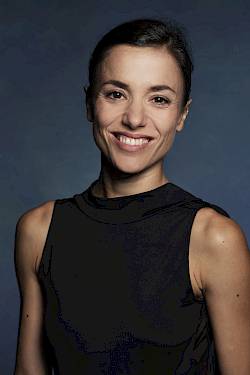
Giulia Tonelli,
Giulia Tonelli
Giulia Tonelli comes from Italy. She graduated from the Balletto di Toscana and the Ballet School of the Vienna State Opera. After her first engagement at the Vienna State Opera, she danced from 2002 to 2010 with the Royal Ballet of Flanders in Antwerp and from 2004 as a demi-soloist. There she danced Giselle (Petipa) as well as solo roles in choreographies of Forsythe, Balanchine, Kylián, Haydée and Spuck. She has been a member of Ballett Zürich since the 2010/11 season, where she has performed ballets by Spoerli, Goecke, McGregor, Lee, Forsythe, Kylián and Balanchine. She danced Julia in Christian Spuck’s Romeo und Julia, Lena in Spuck’s Leonce und Lena and Betsy in Anna Karenina. In Alexei Ratmansky’s Schwanensee reconstruction she danced in the Pas de trois and she also performed in Forsythe’s Quintett and Spuck’s Messa da Requiem. Last season’s highlights include Emergence by Crystal Pite and Gretchen in Edward Clug’s Faust. During the «Junge Choreografen» series she presented the works Mind Games and Klastos together with Mélissa Ligurgo. In 2013 she was awarded the Giuliana Penzi Prize. In 2017 she received the «Tanzpreis der Freunde des Balletts Zürich».

Irmina Kopaczynska,
Irmina Kopaczynska
Irmina Kopaczynska was born in Poland. She studied at the Polish National Ballet School Poznan. She won several prizes in the Polish National Ballet Competition. She also took part in the «Premio Roma» and the «Prix de Lausanne». After two seasons with the Junior Ballett, she became a member of Ballett Zürich starting with the 2011/12 season. She danced the Silver Fairy in Mats Ek’s Dornröschen, Betsy in Christian Spuck’s Anna Karenina, and the Nursemaid in Spuck’s Romeo und Julia. She has also appeared in choreographies by William Forsythe (In the middle, New Sleep), Hans van Manen (Kammerballett), Jiří Kylián (Gods and Dogs, Bella Figura), Iacopo Godani, Edward Clug, Marco Goecke (including the Mother in Nijinski), Douglas Lee, and Crystal Pite.
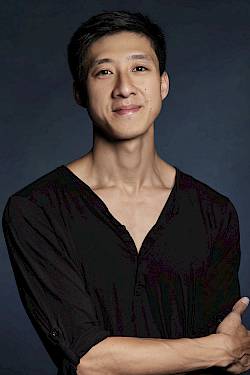
Wei Chen,
Wei Chen
Wei Chen comes from the USA and received his education at the Boston Ballet School, the Margo Marshall School of Ballet, the Walnut Hill School, and the Houston Ballet’s Ben Stevenson Academy. At the Royal Ballet of Flanders he danced in Marcia Haydées Schwanensee (Siegfried) and Dornröschen (Prince Desiré) as well as in Cranko’s Onegin (Lensky). He has also appeared in choreographies by Balanchine, Bournonville, Dawson, Forsythe, Godani, McGregor, Nureyev, Pite, Stevenson, and Wheeldon. He has been a member of Ballett Zürich since the 2013/14 season and has performed in choreographies by Douglas Lee, Jiří Kylián, Marco Goecke, Edward Clug, William Forsythe, and Crystal Pite, among others. He also danced Romeo and Mercutio in Spuck’s Romeo und Julia, Benno in Ratmansky’s Schwanensee, Coppelius in Spuck’s Der Sandmann, and Albrecht in Patrice Bart’s Giselle.
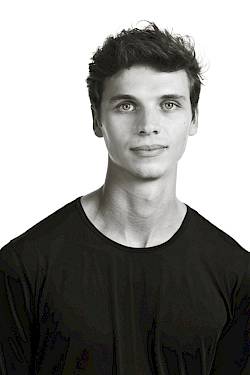
Mark Geilings,
Mark Geilings
Mark Geilings comes from Australia, where he was trained at the Australian Ballet School. He danced with the Leipzig Ballet from 2012-2015, where he performed in choreographies by Uwe Scholz, Mario Schröder (the title role in Otello), Meryl Tankard (Cinderella), Ohad Naharin, and Cayetano Soto. He was a member of Gauthier Dance in Stuttgart for the 2015/16 season, where he performed in Marco Goecke’s Nijinsky. He has been a member of Ballett Zürich since the 2016/17 season, where he has appeared in Petruschka by Marco Goecke, Kammerballett by Hans van Manen, Gods and Dogs by Jiří Kylián, Lady with a Fan by Douglas Lee, and as Mercutio in Spuck’s Romeo und Julia, among others.

Mélanie Borel,
Mélanie Borel
Mélanie Borel comes from France. She studied at the École Nationale Supérieure de Danse in Marseille and at the École de Danse de l’Opéra de Paris. Engagements have taken her to the Ballet de l’Opéra National de Bordeaux and, from 2005 to 2008, to the Peter Schaufuss Ballet in Denmark. She has been a member of Ballett Zürich since the 2008/09 season and has performed as a soloist in choreographies by Twyla Tharp, Heinz Spoerli, and Mats Ek. She was the Haushofmeister in Spuck’s Leonce und Lena and danced the «Cholerisch» variation in Balanchine’s The Four Temperaments. In addition, she has appeared in choreographies by Marco Goecke, Douglas Lee, Jiří Kylián, Wayne McGregor, Martin Schläpfer, Hans van Manen, Edward Clug and Crystal Pite.
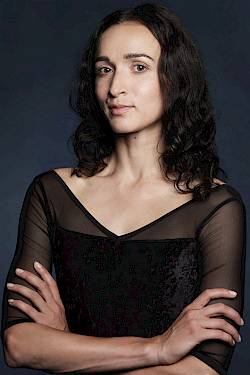
Inna Bilash,
Inna Bilash
Inna Bilash comes from Ukraine. She studied ballet at the Kharkov Choreographic School, the Perm State Choreographic College and the Perm State Academy of Arts and Culture. She was a principal dancer in the Perm Ballet, where she appeared as Julia in Kenneth MacMillan’s Romeo und Julia, Odette/Odile in Natalia Makorova’s Schwanensee, Giselle in the choreography of Perrot/Coralli/Petipa, the Bride in Kylián’s Les Noces and Masha in MacMillan’s Winter Dreams. She has also appeared as a soloist in choreographies by Jerome Robbins, George Balanchine and Douglas Lee. She won the Arabesque Competition in Perm and the Bolshoi Ballet Television Competition. In 2017 she was awarded the prize from the ballet magazine «The Soul of Dance». Inna Bilash has been a member of Ballett Zürich since the 2018/19 season and has appeared in a variety of roles, including as the title role in Patrice Bart’s Giselle.
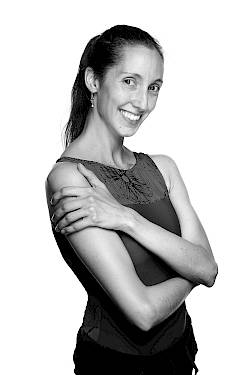
Alba Sempere Torres,
Alba Sempere Torres
Alba Sempere Torres is Spanish. She trained at the Institut del Teatro in Barcelona and at the John Cranko School in Stuttgart. She won the Castellón Ballet Competition and danced with the Vienna State Opera Ballet, the Staatsballett Berlin and, from 2004 to 2008 with the Bayerisches Staatsballett. She has appeared in choreographies by Jo Strømgren, Peter Wright, Jiří Kylián, Vladimir Malakhov, John Neumeier and Mats Ek, among others. She has belonged to Ballett Zürich since the 2014/15 season, where she has been seen in choreographies by Jiří Kylián, Hans van Manen, George Balanchine, Patrice Bart, Martin Schläpfer, and Christian Spuck.
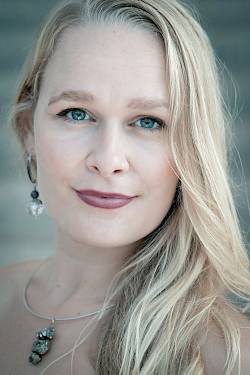
Siena Licht Miller,
Siena Licht Miller
Siena Licht Miller, deutsch-amerikanische Mezzosopranistin, studierte am Curtis Institute of Music und am Oberlin Conservatory of Music Gesang. Sie vervollständigte ihre Ausbildung mit Kursen an der Opera Philadelphia, der Santa Fe Opera, dem Opera Theatre of St. Louis und beim Aspen Music Festival. Sie ist Stipendiatin der Bagby Foundation, Preisträgerin der Metropolitan Opera National Council Auditions, der Marilyn Horne Rubin Foundation und der Gerda Lissner Foundation. Höhepunkte ihrer bisherigen Karriere waren die Rollendebüts als Hermia in A Midsummer Night’s Dream, Zweite Dame in Die Zauberflöte und eine der zwei Solopartien in der Uraufführung von Denis and Katya von Philip Venables an der Opera Philadelphia. Am Aspen Opera Center sang sie die Titelrolle in Ravels L’Enfant et les sortilèges unter der Leitung von Robert Spano. Regelmässig widmet sie sich zudem dem Liedgesang. So sang sie bei der Reihe The Song Continues in der Carnegie Hall zur Feier ihrer Mentorin Marilyn Horne und ging mit einem Rezital zusammen mit dem Pianisten Kevin Murphy auf Tournee durch die USA. In der Spielzeit 2020/21 war sie Mitglied des Internationalen Opernstudios in Zürich und sang hier u. a. in Maria Stuarda, Simon Boccanegra, Viva la mamma, Salome, Odyssee, im Ballett Monteverdi, in L’italiana in Algeri sowie Flosshilde in Das Rheingold. Seit der Spielzeit 2022/23 gehört sie zum Ensemble des Opernhauses Zürich und war hier jüngst in Barkouf, Salome, Anna Karenina, Lakmé, La rondine, Die Walküre, Götterdämmerung, Andrea Chénier und Ariadne auf Naxos zu erleben. Ausserdem sang sie am Theater Winterthur die Titelpartie in Händels Serse.
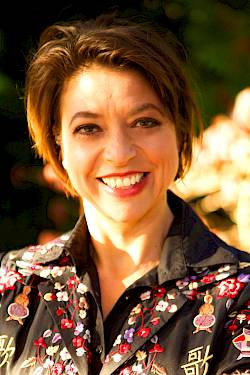
Judith Schmid,
Judith Schmid
Judith Schmid, Schweizer Mezzosopranistin, studierte Musik und Bewegung an der Hochschule der Künste Bern sowie Gesang an der Guildhall School of Music and Drama. Sie legt ihren Schwerpunkt auf die Opern- und Konzertbühne, widmet sich jedoch auch dem Lied und Oratorium. Seit über 20 Jahren ist sie u.a. am Opernhaus Zürich, wo sie langjähriges Ensemblemitglied war, oder auch am Staatstheater Nürnberg engagiert, etwa in Hosenrollen wie Smeton (Anna Bolena), Sesto (Giulio Cesare) und Silla (Palestrina) sowie als Adelaide (Arabella), Polina (Pique Dame), Federica (Luisa Miller), Maddalena (Rigoletto) Emilia (Otello), Erda (Rheingold, Siegfried), Waltraute (Walküre) sowie Erste Norn und Flosshilde (Götterdämmerung). Im Konzertbereich trat sie mit Orchestern wie dem Symphonieorchester des Bayerischen Rundfunks, dem Münchner Rundfunkorchester, dem Opern- und dem Tonhalle Orchester Zürich unter Dirigenten wie Plácido Domingo, Mariss Jansons, Daniele Gatti, Franz Welser-Möst, Nello Santi, Marc Minkowski, Adam Fischer, Marcello Viotti oder Heinz Holliger auf. Seit 2017 ist sie Dozentin für Gesang an der Hochschule Luzern, ab September 2024 mit künstlerischer Professur. Neben zahlreichen Radio- und Fernsehaufzeichnungen sowie DVD-Produktionen hat Judith Schmid auch CDs veröffentlicht. Das Album Rosenblätter mit dem Pianisten Oliver Schnyder und Werken von Grieg, Hefti und Ravel wurde 2008 vom Schweizer Radio SRF 2 Kultur zu den besten CDs gewählt. Zuletzt sang sie am Opernhaus Zürich die Rolle der Suzuki in der Wiederaufnahme von Madama Butterfly. Ein weiteres Engagement ist in der Spielzeit 2025/26 am Luzerner Theater geplant.
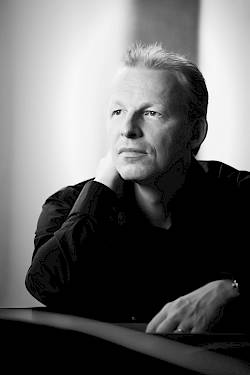
Adrian Oetiker,
Adrian Oetiker
Der Schweizer Pianist Adrian Oetiker verfolgt seit vielen Jahren eine weltweite Karriere. Er studierte er in der Meisterklasse von Homero Francesch an der Zürcher Hochschule der Künste und bei Bella Davidovich an der Juilliard School in New York. Auch Lazar Berman zählte zu seinen Lehrern. 1995 gewann er den ARD-Wettbewerb in München. Konzerte in Europa, Amerika und Australien führten ihn mit vielen Orchestern zusammen, darunter das Tonhalle-Orchester Zürich, das Symphonie-Orchester des Bayerischen Rundfunks, die Staatskapelle Dresden, das Irish National Symphony Orchestra und das Melbourne Symphony Orchestra. Bei wiederholten Einladungen nach Australien trat er mit den meisten Orchestern des Kontinents auf. Mit dem Orchestre Symphonique de Mulhouse unter Daniel Klajner spielte er von 2006 bis 2008 alle Klavierkonzerte von Béla Bartók. Rezitals und Kammermusik-Programme spielte er u.a. in der Berliner Philharmonie, im Gewandhaus Leipzig, im Festspielhaus Salzburg, im KKL und im Teatro La Fenice in Venedig. Er musiziert regelmässig im Klavierduo Paola & Adrian Oetiker und ist Pianist im Feininger Trio der Berliner Philharmoniker. Mehrere Ballettproduktionen am Opernhaus Zürich, an der Semperoper Dresden, an der Bayerischen Staatsoper und an der Deutschen Oper Berlin, u.a. mit Christian Spuck, runden seine vielfältigen Tätigkeiten ab. Adrian Oetiker ist Künstlerischer Leiter der Internationalen Sommerakademie Ettal und war von 1996 bis 2021 Professor für Klavier an der Hochschule für Musik Basel. 2011 wurde er als Professor an die Hochschule für Musik und Theater in München berufen.


